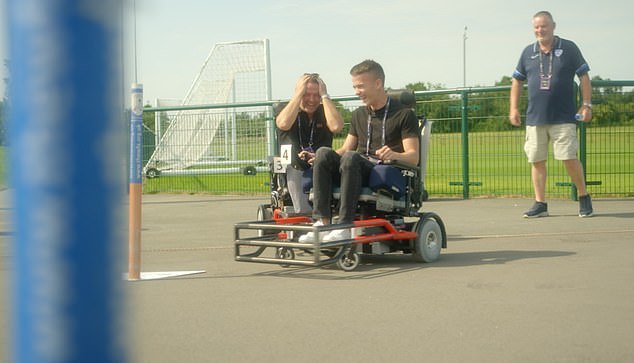Warning signs of Stargardt’s disease in children revealed after Michael Owen revealed 17-year-old son’s incurable condition that left him clinically blind
Michael Owen today revealed how he wished he could give his 17-year-old son his own eyes after opening up about his family’s pain over Stargardt’s disease – the incurable condition that has left his child clinically blind.
James was diagnosed with Stargardt at the age of eight.
Michael told Mail Sport in an exclusive interview that his son’s diagnosis was difficult to come to terms with at first and recalled privately breaking down after hearing about the impact it would have on James’ life.
Stargardt disease is a hereditary eye condition, meaning it is passed from parents to children. It is not contagious.
It is caused by a faulty gene that leads to a build-up of fatty deposits on the macula, a small part of the retina that is crucial for achieving sharp central vision.
This type of vision is critical for activities that require you to see things in great detail, such as watching TV or reading.
Stargardt disease has no cure and is progressive, gradually getting worse over time.
Ultimately, most people with Stargardt disease will see the same level of detail at 20 feet away as normal people do at a distance of 200 to 400 feet.
Patients can retain their peripheral vision, which is what people see out of the corner of their eyes, but the extent of their vision loss is so great that they become clinically blind.
Early symptoms include difficulty reading or seeing in low light, loss of detailed vision or color vision, wavy vision, as well as blind spots and blurriness in the central part of the eye.
These symptoms are usually noticed in children between the ages of six and twelve, although they can also rarely occur later in life.
The diagnosis is usually made by an optician or optometrist, who can use their equipment to spot the build-up of fatty deposits on the retina.
Although there is no cure, treatments are available to slow, but not stop, the progression of the disease.
These include using UV-blocking sunglasses to prevent sunlight from further deteriorating vision, and avoiding high amounts of vitamin A.
Vitamin A, found in leafy vegetables, dairy and liver, is normally good for vision, but some people with Stargardt cannot process it properly, meaning it actually harms the health of their eyes.
Patients with Stargardt are also told to avoid lifestyle factors that damage vision in general, such as smoking, excessive alcohol consumption and being fat.
While scientists are experimenting with stem cell treatments to regrow parts of the eye damaged by the condition, these clinical trials are still ongoing.
Stargardt does not affect other aspects of health, meaning patients still have a normal life expectancy.
The risk of passing Stargardt on to your children depends on the form of the gene you have.
Michael Owen’s close-knit family includes son James (top right), 29-year-old wife Louise (bottom left) and daughters Jessica, Gemma and Emily (left to right)

Owen and his son hope to raise awareness of Stargardt’s eye conditions and others through their new documentary ‘Football is For Everyone’
Stargardt is passed on in a dominant or recessive form.
In the most common type (recessive), both parents need a copy of the disease-causing gene to potentially pass it on to their children.
Still, the parents themselves will have a healthy version of the gene, which will usually counteract the defective version, meaning they probably won’t show any signs of Stargardt. Their children may not be so lucky.
There is a 25 percent chance that a child will inherit the defective gene from both parents and develop Stargardt.
This genetic throw means that Stargardt can often run in families with no history of the disease.
In the dominant form, the disease is passed on directly from a parent who has Stargardt.
This gives a child a 50 percent chance of developing the disease themselves, depending on which gene they inherit from their parents.
If a child does not inherit the gene that causes the disease, they cannot pass the gene on to their own children.
Unlike some other genetic diseases, which are linked to certain sex chromosomes, Stargardt has an equal chance of affecting boys and girls.
People with Stargardt are often invited to participate in genetic testing after their diagnosis.
This helps them and their families learn more about the specifics of their gene, the implications for their relatives and for any children they may have in the future.
It is estimated that one in 8,000 to 10,000 people has Stargardt.
